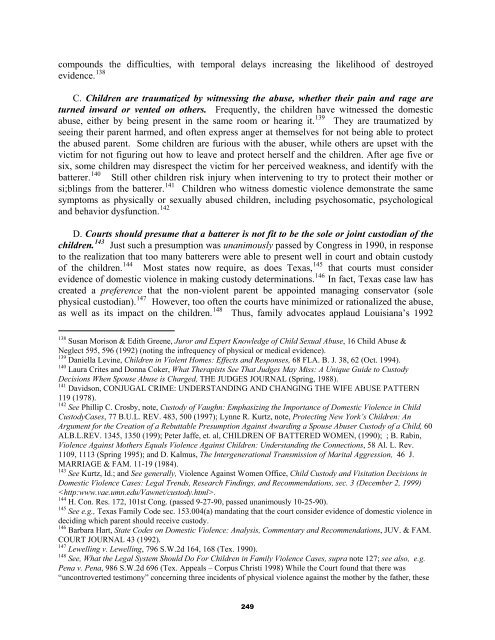A Judge’s Guide
A Judge’s Guide
A Judge’s Guide
Create successful ePaper yourself
Turn your PDF publications into a flip-book with our unique Google optimized e-Paper software.
compounds the difficulties, with temporal delays increasing the likelihood of destroyed<br />
evidence. 138<br />
C. Children are traumatized by witnessing the abuse, whether their pain and rage are<br />
turned inward or vented on others. Frequently, the children have witnessed the domestic<br />
abuse, either by being present in the same room or hearing it. 139 They are traumatized by<br />
seeing their parent harmed, and often express anger at themselves for not being able to protect<br />
the abused parent. Some children are furious with the abuser, while others are upset with the<br />
victim for not figuring out how to leave and protect herself and the children. After age five or<br />
six, some children may disrespect the victim for her perceived weakness, and identify with the<br />
batterer. 140 Still other children risk injury when intervening to try to protect their mother or<br />
si;blings from the batterer. 141 Children who witness domestic violence demonstrate the same<br />
symptoms as physically or sexually abused children, including psychosomatic, psychological<br />
and behavior dysfunction. 142<br />
D. Courts should presume that a batterer is not fit to be the sole or joint custodian of the<br />
children. 143 Just such a presumption was unanimously passed by Congress in 1990, in response<br />
to the realization that too many batterers were able to present well in court and obtain custody<br />
of the children. 144 Most states now require, as does Texas, 145 that courts must consider<br />
evidence of domestic violence in making custody determinations. 146 In fact, Texas case law has<br />
created a preference that the non-violent parent be appointed managing conservator (sole<br />
physical custodian). 147 However, too often the courts have minimized or rationalized the abuse,<br />
as well as its impact on the children. 148 Thus, family advocates applaud Louisiana’s 1992<br />
138 Susan Morison & Edith Greene, Juror and Expert Knowledge of Child Sexual Abuse, 16 Child Abuse &<br />
Neglect 595, 596 (1992) (noting the infrequency of physical or medical evidence).<br />
139 Daniella Levine, Children in Violent Homes: Effects and Responses, 68 FLA. B. J. 38, 62 (Oct. 1994).<br />
140 Laura Crites and Donna Coker, What Therapists See That Judges May Miss: A Unique <strong>Guide</strong> to Custody<br />
Decisions When Spouse Abuse is Charged, THE JUDGES JOURNAL (Spring, 1988).<br />
141 Davidson, CONJUGAL CRIME: UNDERSTANDING AND CHANGING THE WIFE ABUSE PATTERN<br />
119 (1978).<br />
142 See Phillip C. Crosby, note, Custody of Vaughn: Emphasizing the Importance of Domestic Violence in Child<br />
CustodyCases, 77 B.U.L. REV. 483, 500 (1997); Lynne R. Kurtz, note, Protecting New York’s Children: An<br />
Argument for the Creation of a Rebuttable Presumption Against Awarding a Spouse Abuser Custody of a Child, 60<br />
ALB.L.REV. 1345, 1350 (199); Peter Jaffe, et. al, CHILDREN OF BATTERED WOMEN, (1990); ; B. Rabin,<br />
Violence Against Mothers Equals Violence Against Children: Understanding the Connections, 58 Al. L. Rev.<br />
1109, 1113 (Spring 1995); and D. Kalmus, The Intergenerational Transmission of Marital Aggression, 46 J.<br />
MARRIAGE & FAM. 11-19 (1984).<br />
143 See Kurtz, Id.; and See generally, Violence Against Women Office, Child Custody and Visitation Decisions in<br />
Domestic Violence Cases: Legal Trends, Research Findings, and Recommendations, sec. 3 (December 2, 1999)<br />
.<br />
144 H. Con. Res. 172, 101st Cong. (passed 9-27-90, passed unanimously 10-25-90).<br />
145 See e.g., Texas Family Code sec. 153.004(a) mandating that the court consider evidence of domestic violence in<br />
deciding which parent should receive custody.<br />
146 Barbara Hart, State Codes on Domestic Violence: Analysis, Commentary and Recommendations, JUV. & FAM.<br />
COURT JOURNAL 43 (1992).<br />
147 Lewelling v. Lewelling, 796 S.W.2d 164, 168 (Tex. 1990).<br />
148 See, What the Legal System Should Do For Children in Family Violence Cases, supra note 127; see also, e.g.<br />
Pena v. Pena, 986 S.W.2d 696 (Tex. Appeals – Corpus Christi 1998) While the Court found that there was<br />
“uncontroverted testimony” concerning three incidents of physical violence against the mother by the father, these<br />
249


